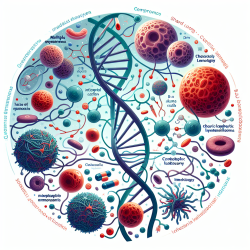Introduction
Recent research has unveiled intriguing genetic correlations between multiple myeloma (MM) and chronic lymphocytic leukemia (CLL), both of which are B-cell malignancies. The study titled "Genetic correlation between multiple myeloma and chronic lymphocytic leukaemia provides evidence for shared aetiology" provides compelling evidence for shared genetic pathways influencing the development of these diseases. This blog aims to guide practitioners on how they can utilize these findings to enhance their clinical practice and encourage further research in this area.
Key Findings from the Research
The study utilized cross-trait linkage disequilibrium (LD)-score regression on genome-wide association study (GWAS) datasets, encompassing 11,734 cases and 29,468 controls. The analysis revealed a significant genetic correlation between MM and CLL (Rg = 0.4, P = 0.0046). Moreover, it identified shared risk loci, with four of the 45 known CLL risk loci associating with MM risk and five of the 23 known MM risk loci associating with CLL risk. These loci are enriched for B-cell regulatory elements and implicate B-cell developmental genes.
Implications for Practitioners
Understanding the shared genetic pathways can significantly impact clinical practice:
- Risk Assessment: Genetic testing can be refined to include shared loci, improving risk assessment for patients with a family history of B-cell malignancies.
- Targeted Therapies: Identifying common genetic pathways opens avenues for developing targeted therapies that could be effective across both MM and CLL.
- Patient Education: Practitioners can educate patients about the genetic risks associated with B-cell malignancies, emphasizing the importance of regular screenings.
Encouraging Further Research
The findings underscore the need for further research to validate these genetic correlations and explore their clinical applications. Practitioners are encouraged to participate in or support research initiatives that aim to deepen our understanding of the genetic underpinnings of B-cell malignancies. Collaboration with geneticists and oncologists can facilitate the translation of research findings into clinical practice.
Conclusion
The genetic correlation between MM and CLL offers a promising avenue for improving diagnosis, treatment, and prevention strategies for B-cell malignancies. By integrating these insights into clinical practice, practitioners can enhance patient outcomes and contribute to the broader understanding of these complex diseases.
To read the original research paper, please follow this link: Genetic correlation between multiple myeloma and chronic lymphocytic leukaemia provides evidence for shared aetiology.










